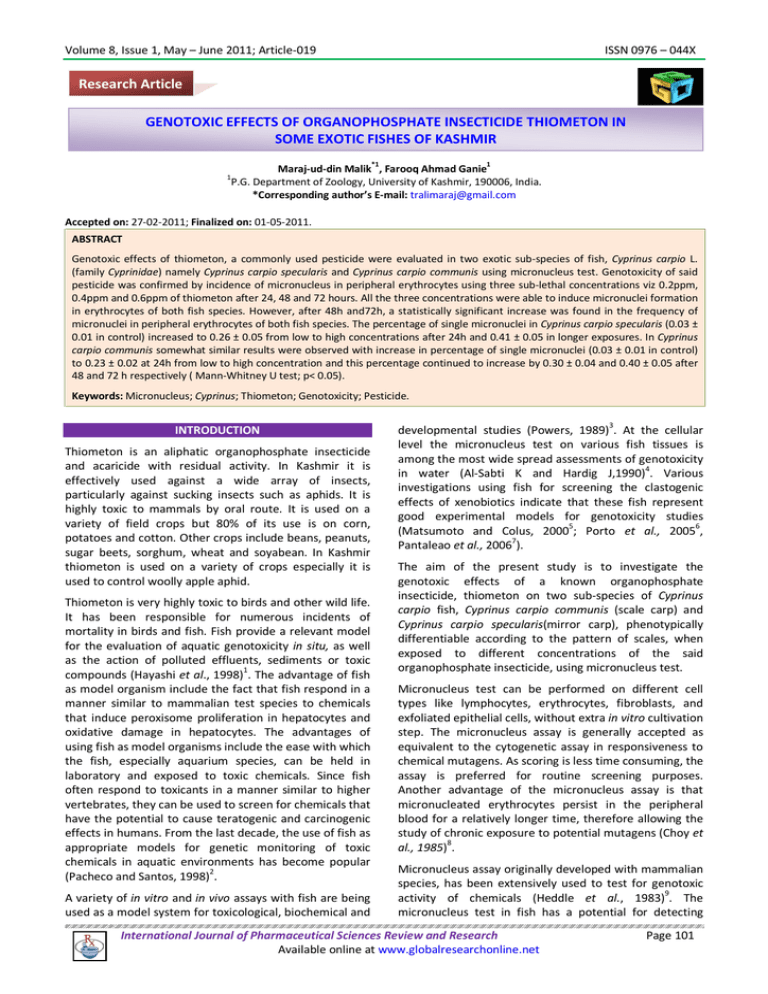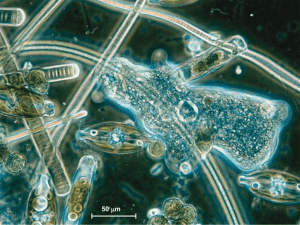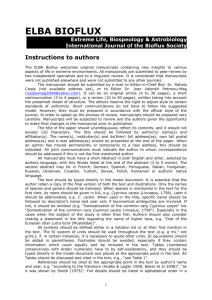Document 13308539
advertisement

Volume 8, Issue 1, May – June 2011; Article-019 ISSN 0976 – 044X Research Article GENOTOXIC EFFECTS OF ORGANOPHOSPHATE INSECTICIDE THIOMETON IN SOME EXOTIC FISHES OF KASHMIR *1 1 1 Maraj-ud-din Malik , Farooq Ahmad Ganie P.G. Department of Zoology, University of Kashmir, 190006, India. *Corresponding author’s E-mail: tralimaraj@gmail.com Accepted on: 27-02-2011; Finalized on: 01-05-2011. ABSTRACT Genotoxic effects of thiometon, a commonly used pesticide were evaluated in two exotic sub-species of fish, Cyprinus carpio L. (family Cyprinidae) namely Cyprinus carpio specularis and Cyprinus carpio communis using micronucleus test. Genotoxicity of said pesticide was confirmed by incidence of micronucleus in peripheral erythrocytes using three sub-lethal concentrations viz 0.2ppm, 0.4ppm and 0.6ppm of thiometon after 24, 48 and 72 hours. All the three concentrations were able to induce micronuclei formation in erythrocytes of both fish species. However, after 48h and72h, a statistically significant increase was found in the frequency of micronuclei in peripheral erythrocytes of both fish species. The percentage of single micronuclei in Cyprinus carpio specularis (0.03 ± 0.01 in control) increased to 0.26 ± 0.05 from low to high concentrations after 24h and 0.41 ± 0.05 in longer exposures. In Cyprinus carpio communis somewhat similar results were observed with increase in percentage of single micronuclei (0.03 ± 0.01 in control) to 0.23 ± 0.02 at 24h from low to high concentration and this percentage continued to increase by 0.30 ± 0.04 and 0.40 ± 0.05 after 48 and 72 h respectively ( Mann-Whitney U test; p< 0.05). Keywords: Micronucleus; Cyprinus; Thiometon; Genotoxicity; Pesticide. INTRODUCTION Thiometon is an aliphatic organophosphate insecticide and acaricide with residual activity. In Kashmir it is effectively used against a wide array of insects, particularly against sucking insects such as aphids. It is highly toxic to mammals by oral route. It is used on a variety of field crops but 80% of its use is on corn, potatoes and cotton. Other crops include beans, peanuts, sugar beets, sorghum, wheat and soyabean. In Kashmir thiometon is used on a variety of crops especially it is used to control woolly apple aphid. Thiometon is very highly toxic to birds and other wild life. It has been responsible for numerous incidents of mortality in birds and fish. Fish provide a relevant model for the evaluation of aquatic genotoxicity in situ, as well as the action of polluted effluents, sediments or toxic compounds (Hayashi et al., 1998)1. The advantage of fish as model organism include the fact that fish respond in a manner similar to mammalian test species to chemicals that induce peroxisome proliferation in hepatocytes and oxidative damage in hepatocytes. The advantages of using fish as model organisms include the ease with which the fish, especially aquarium species, can be held in laboratory and exposed to toxic chemicals. Since fish often respond to toxicants in a manner similar to higher vertebrates, they can be used to screen for chemicals that have the potential to cause teratogenic and carcinogenic effects in humans. From the last decade, the use of fish as appropriate models for genetic monitoring of toxic chemicals in aquatic environments has become popular (Pacheco and Santos, 1998)2. A variety of in vitro and in vivo assays with fish are being used as a model system for toxicological, biochemical and developmental studies (Powers, 1989)3. At the cellular level the micronucleus test on various fish tissues is among the most wide spread assessments of genotoxicity in water (Al-Sabti K and Hardig J,1990)4. Various investigations using fish for screening the clastogenic effects of xenobiotics indicate that these fish represent good experimental models for genotoxicity studies (Matsumoto and Colus, 20005; Porto et al., 20056, Pantaleao et al., 20067). The aim of the present study is to investigate the genotoxic effects of a known organophosphate insecticide, thiometon on two sub-species of Cyprinus carpio fish, Cyprinus carpio communis (scale carp) and Cyprinus carpio specularis(mirror carp), phenotypically differentiable according to the pattern of scales, when exposed to different concentrations of the said organophosphate insecticide, using micronucleus test. Micronucleus test can be performed on different cell types like lymphocytes, erythrocytes, fibroblasts, and exfoliated epithelial cells, without extra in vitro cultivation step. The micronucleus assay is generally accepted as equivalent to the cytogenetic assay in responsiveness to chemical mutagens. As scoring is less time consuming, the assay is preferred for routine screening purposes. Another advantage of the micronucleus assay is that micronucleated erythrocytes persist in the peripheral blood for a relatively longer time, therefore allowing the study of chronic exposure to potential mutagens (Choy et al., 1985)8. Micronucleus assay originally developed with mammalian species, has been extensively used to test for genotoxic activity of chemicals (Heddle et al., 1983)9. The micronucleus test in fish has a potential for detecting International Journal of Pharmaceutical Sciences Review and Research Available online at www.globalresearchonline.net Page 101 Volume 8, Issue 1, May – June 2011; Article-019 clastogenic activity. Various studies have shown that the peripheral erythrocytes of fish have a high incidence of micronuclei after exposure to different pollutants under fold and laboratory conditions. MATERIALS AND METHODS Experimental animals Two sub-species of Cyprinus carpio L. (family Cyprinidae) namely Cyprinus carpio specularis and Cyprinus carpio communis were used as experimental animals as they are available throughout the year in Kashmir. Adult specimens of both sub-species were collected from Dallake and were identified on the basis of their scales. Fish 0 were acclimatized for 45 days at 28 C prior to trials 10 (Anitha et al., 2000) . Specimens were kept in polypropylene troughs each with 7-8 individuals/50 L of water. Water was kept O2 saturated by aeration. The troughs were cleaned daily and the water as well as the pesticide was renewed to keep the concentration constant throughout the test period of 24, 48, 72 h. Control fish were kept in dechlorinated tap water without any treatment. Fish were fed commercial fish feed daily at least one hour prior to the replacement of water. Only healthy, active fish starved for 24hr were used for the experiment and they were allowed no food during treatment procedures. Insecticide chemical and dose selection The commercial grade of thiometon was obtained from G.M.Shah pesticides, Srinagar; manufactured from Cyanamid, India Ltd. (Bombay).On the basis of literature data (LC50 values for thiometon), three sub-lethal concentrations (0.2ppm, 0.4ppm and 0.6ppm) of thiometon were then selected for the experiment. Experimental design Group I (Control): One group of fish from each subspecies was selected as control, kept in chlorinated water without any treatment. They were fed once daily commercial fish feed. Group II: The fish sample from two sub-species was subdivided into three sub groups each, based on the dose selection of the insecticide. All subgroups had equal number of fishes (five fish/group/duration) maintained in 50 litre/polypropylene troughs. After treatment with insecticide, the frequencies of micronuclei in all experimental sub-groups were examined at three durations (24, 48 and 72h) and at each concentration Cytogenetic studies using micronucleus test The method of Schmid (1975)11 was used. The fish were injected with 0.1 ml of 0.025% colchicine and sacrificed two hours later with a slight blow on the head region. Chemical treated and control fish were cut in the caudal. From the freshly collected blood, smears were made on grease free slides. After fixation using methanol as fixative, slides were stained with Mayer’s hematoxylin, rinsed in Scott’s tap water substitute, followed by another ISSN 0976 – 044X 12 staining in eosin (Pascoe and Gatehouse, 1986) . After completion of this staining process, the slides were then washed in 30%, 50%, 70% and 90% alcohol, cleaned in xylene and mounted using D.P.X. The slides were then examined using a simple light microscope. For each concentration and duration, five fish specimens were used and from each fish, six slides were studied and 1200cells were scored under X 600 magnification. Statistical analysis Statistical analysis of data to verify the significant difference in the incidence of micronuclei between treated and control groups at 0.05 and 0.01 level of significance was performed using non-parametric criteria, Mann-Whitney U test to analyze the frequency of micronuclei. RESULTS The genotoxicity of thiometon in Cyprinus carpio specularis and Cyprinus carpio communis was confirmed by incidence of micronucleus in peripheral erythrocytes after 24, 48 and 72 hours. Three sub-lethal concentrations of thiometon, 0.2 ppm, 0.4 ppm and 0.6 ppm were used, and it was observed that all these concentrations were able to induce micronucleus formation in erythrocytes of both the fish species. No increased incidence of micronucleated erythrocytes of Cyprinus carpio specularis and Cyprinus carpio communis was reported with sub lethal concentration of 0.2 ppm after 24-hour intervals. However, after 48h and 72h, a statistically significant increase was found in the frequency of micronuclei in peripheral erythrocytes of both fish species. The percentage of single micronuclei in Cyprinus carpio specularis (0.03±0.01 of control) increased to 1.15±0.32 from low to high concentrations after 24 h and continued to increase by 1.78±0.30 and 2.74±0.52 in longer exposures table 1 and table 2). In Cyprinus carpio communis somewhat similar results were observed with increase in percentage of single micronuclei (0.03±0.01 control) to 1.30±0.23 at 24 h from low to high concentration and this percentage continued to increase by 2.08±0.31 and 2.91±0.39 after 48 and 72 h respectively. Statistical analysis showed significant difference in the frequency of incidence of micronuclei in the erythrocytes of control and frequency of micronuclei in the erythrocytes of thiometon treated groups of Cyprinus carpio specularis and Cyprinus carpio communis respectively (Mann-Whitney U test; P< 0.05). Both dose and time dependent increase in the micronuclei frequency was observed in treated fish species and a peak value detected at higher concentrations after 72h of thiometon injection, clearly showed a higher incidence of micronucleated peripheral erythrocytes. International Journal of Pharmaceutical Sciences Review and Research Available online at www.globalresearchonline.net Page 102 Volume 8, Issue 1, May – June 2011; Article-019 ISSN 0976 – 044X Table 1: Micronucleus frequencies (%) in peripheral blood erythrocytes of Cyprinus carpio specularis exposed to different concentrations of Thiometon. MN frequencies (%) Treatment Concentration 24 h 48 h 72 h Mean ± SD Control 0.03 ± 0.01 0.05 ± 0.01 0.05 ± 0.01 * 2.6 ppm 0.04 ± 0.01 0.06 ± 0.03 0.09 ± 0.03* * * * Phorate 4.6 ppm 0.11 ± 0.03 0.16 ± 0.03 0.20 ± 0.03 6.6 ppm 0.26 ± 0.05* 0.28 ± 0.04* 0.41 ± 0.05* (Mann-Whitney U test) * P < 0.05 Table 2: Micronucleus frequencies (%) in peripheral blood erythrocytes of Cyprinus carpio communis exposed to different concentrations of Thiometon. MN frequencies (%) Treatment Concentration 24 h 48 h 72 h Mean ± SD Mean ± SD Mean ± SD Control 0.03 ± 0.01 0.04 ± 0.01 0.05 ± 0.01 * 2.6 ppm 0.04 ± 0.01 0.06 ± 0.01 0.10 ± 0.03* Phorate 4.6 ppm 0.12± 0.01* 0.17 ± 0.04* 0.22 ± 0.02* 6.6 ppm 0.23± 0.02* 0.30 ± 0.04* 0.40 ± 0.05* (Mann-Whitney U test) * P < 0.05 DISCUSSION Organophosphate insecticides are ubiquitous environmental contaminants because of their wide applications in agriculture. It is known that in fishes organophosphate pesticides are neurotoxic and they inhibit acetylcholinesterase activity with subsequent disruption of nervous functions, thereby interfering with some of the vital physiological functions (Rao and Rao, 1983)13. Since organophosphate insecticides are finding increasing use in recent years, this can result in acute and long term side effects, including sickness and death of people, useful animals, fish, birds and destruction of crops. In the present study, positive genotoxic effects, measured as micronucleus frequency in erythrocytes from both fish species (Cyprinus carpio specularis and Cyprinus carpio communis) exposed to different doses of Thiometon were observed. The result of the present study revealed a significant induction of micronuclei in peripheral erythrocytes (p<0.01 and p<0.05) of both fish species. The appearance of inter-specific differences observed in the present study could be attributed to the specificity of DNA repair, cell turnover time, physiological peculiarities, contaminant uptake or biotransformation in the fish species studied. On the other hand age, sex, reproductive status, genetic constitution may affect micronucleus frequency in fish (Al-Sabti et al., 1994)14. However, Cyprinus carpio specularis and Cyprinus carpio communis in the present study were selected from the same age groups. The exposure was performed in the laboratory under standard experimental conditions, Therefore, the interspecific differences in micronuclei incidences should not be attributed to the intrinsic problems of the experimental system used. In the present study a significant difference in the micronucleus incidence among treated and control groups was observed. The peak frequency of micronucleated erythrocytes was observed at 72h after exposure. The length of cell cycle critical to micronuclei formation depends upon the time needed to replicate DNA and perform nuclear division. In man and mice the duration of the cell cycle has been well documented. There is, however, little information on the duration of the cell cycle in the tissues of teleost species since the cell cycle varies with temperature in piokilotherms (Al-Sabti and 15 Metcalfe, 1995) . The incubation times were chosen without the benefit of specific knowledge of the times 16 required for the division of fish cells (Al-Sabti, 1994) . A time dependent increase in the incidence of micronuclei in peripheral erythrocytes of Cyprinus carpio specularis and Cyprinus carpio communis was established and confirms other observations (Al-Sabti, 198617; Nepomuceno and Spano,199518;Nepomuceno et al., 199719;Gustavino et al., 200120;Buschini et al.,200421). Thiometon in the present study was also found to induce micronuclei in peripheral erythrocytes of fish. The present study reveals that micronucleus assay has a great potential for detecting clastogenic substances in aqueous media. However, additional experimental evidence is needed to evaluate these hypotheses. Also International Journal of Pharmaceutical Sciences Review and Research Available online at www.globalresearchonline.net Page 103 Volume 8, Issue 1, May – June 2011; Article-019 ISSN 0976 – 044X further studies on aquatic organisms exposed in-vivo as well as in-vitro to various chemicals is certainly needed to clarify the mechanism of micronucleus formation. 11. Schmid W (1975) The micronucleus test. Mutat Res. 31: 9-15. 12. Pascoe S, Gatehouse D (1986) The use of a simple haematoxylin and eosin staining procedure to demonstrate micronuclei within rodent bone marrow. Mutat Res. 164: 237-234. 13. Rao KSP, RKV Rao (1983) Regulation of phosphorylases and aldolases in tissues of the teleost (Tilapia mossambica) under methyl parathion impact. Bull Environ Contam Toxicol. 31: 427-478. 14. Al-Sabti K, Frank M, Andrijanic B, Knez S, Stegnar P (1994) Chromium induced micronuclei in fish. J Appl Toxicol.14: 333-336. 15. Al-Sabti K, Metcalfe CD (1995) Fish micronuclei for assessing genotoxicity in water. Mutat Res. 343: 121135. 16. Al-Sabti K (1994) Micronuclei induced by selenium, mercury, methyl mercury and their mixtures in binucleated blocked fish erythrocyte cells. Mutat Res. 320: 157-163. 17. Al-Sabti (1986) Comparative micronucleated erythrocyte cell induction in three cyprinids by five carcinogenicmutagenic chemicals. Cytobios. 47: 147-154. REFERENCES 1. 2. Hayashi M, Veda T,Uyeno K, Wada K, Kinae, Saotome K, Tanaka N, Takai A, Sasaki YF, Asano N, Sofuni T, Ojimia Y 91998) Development of genotoxicity assay systems that use aquatic organisms. Mutat Res. 399: 125-133. Pacheco M, Santos MA (1998) Induction of liver EROD and erythrocyte nuclear abnormalities by cyclophosphanide and PAHs in Anguilla Anguilla L. Ecotoxicol Environ Saf. 40: 71-76. 3. Powers DA (1989) Fish as model system. Sci. 246: 352358. 4. Al-Sabti K, Hardig J (1990) Micronucleus test in fish for monitoring the genotoxic effects of the industrial waste products in the Baltic Sea, Sweden. Comp. Bioch Physiol. 97C: 179-182. 5. Matsumoto FE, Colus IMS (2000) Micronucleus frequencies in Astyanax bimaculates (characcidae) treated with cyclophosphamide or vinblastine sulphate. Gen Mol Biol. 23: 489-492. 6. Porto JIR, Araujo CSO, Feldberg E (2005) Mutagenic effects of mercury pollution as revealed by micronucleus test on three Amazonian fish species. Environ Res. 97: 287-292. 18. Nepomuceno JC, Spano MA (1995) Induction of micronuclei in peripheral erythrocytes of Cyprinus carpio fish by methyl parathion. International Contaminant Ambient. 11: 9-12. 7. Pantaleao S de M, Alcantara AV, Alves JdoPH, Spano MA (2006) The piscine micronucleus test to assess the impact of pollution on the Japaratuba river in Brazil. Environ Mol Mutagen. 47. 19. Nepomuceno JC, Ferrari I, Spano MA, Centeno AJ (1997) Detection of micronuclei in peripheral erythrocytes of Cyprinus carpio exposed to metallic mercury. Environ Mol Mutagen. 30 (3): 293-297. 8. Choy WN, MacGregor JT, Shelby MD, Maranpot RR (1985) Induction of micronuclei by benzene in B6C3FI mice: retrospective analysis of peripheral blood smears from NTP Carcinogenesios bioassay. Mutat Res. 143: 5559. 20. Gustavino B, Scornajehgi KA, Minissi S, Ciccotti E (2001) Micronuclei induced in erythrocytes of Cyprinus carpio (teleostei, pisces) by X-rays and colchicine. Mutat Res. 494: 151-159. 21. 9. Heddle JA, Hite M, Kirkhart B, Mavourim K, Mac-Gregor jt, Newell GW, Salamon MF(1983) The induction of micronuclei as a measure of genotoxicity. Mutat Res. 123: 61-118. 10. Anitha B, Chandra N, Gopinath PM, Durairaj G (2000) Genotoxicity evaluation of heat shock in gold fish (Carassius auratus). Mutat Res. 469: 1-8. Buschini A, Martino A, Gustavino B, Manfrinotte M, Poli P, Rossi C, Santoro M, Door AJM, Rizzoni M (2004) Comet assay and micronucleus test in circulating erythrocytes of Cyprinus carpio specimens exposed in situ to lake waters treated with disinfectants for potabilization. Mutat Res. 557: 119-129. ***************** International Journal of Pharmaceutical Sciences Review and Research Available online at www.globalresearchonline.net Page 104





